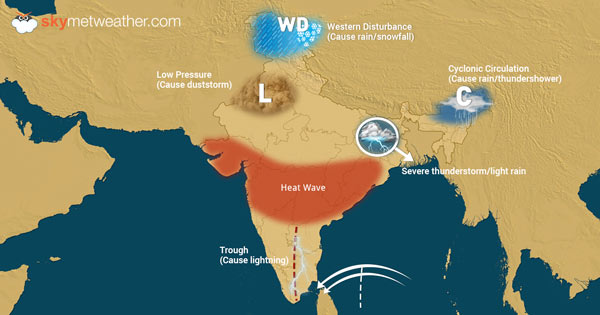
March is a transition month in terms of weather conditions across India. Herein, winters recede from the North Indian region while for the South Indian portion of the country, Pre-Monsoon rains begin to knock doors.
The rainfall amounts are likely to increase as compared to the month of February. However, the weather activity will be largely confined to the southern parts of the country along with Northeast India. Major share of rains is to be recorded from Northeast India, particularly over Assam and Arunachal Pradesh.
Meanwhile, the central portion of India would witness the least amount of rains. In fact, Gujarat does not see any weather activity in terms of rainfall followed by Maharashtra and rest of Central India in March. On the other hand, while rains will continue over the hilly regions of North India, snowfall will now recede and remain confined to the higher reaches.
Weather features across India in March
Western Disturbances: The North Indian region’s weather is dominated by the Western Disturbances and its induced cyclonic circulations. These systems start to shift northwards in February. Now, rainfall activity is expected to continue in the hills. The upper reaches may witness snow while rains will be less over the Plains. However, some rainy spells may be expected in the states of Rajasthan, Punjab, Haryana, Delhi and western parts of Uttar Pradesh. Rise in temperatures are expected to continue over the region.
Kal Baisakhi: The topography of Chhotanagpur region plays a very important part in initiating the weather activity over eastern parts of India. This period is known as Kal Baisakhi or the time when nor ‘westers affect the region. As the season progresses, weather activity in terms of squally winds, scary lightning, frightening thunderstorm, rain as well as hailstorm becomes more violent. These thunderstorms travel across Ranchi and Jamshedpur up to Panagarh, Midnapore, Kolkata and mostly affect during the late afternoon and evening hours.
[yuzo_related]
In terms of severity, East India will observe the most severe weather conditions, particularly during the second half of the month which will increase as April begins.
Cyclonic Circulations: During this time, the seasonal cyclonic circulation over Northeast India keeps getting activated as the systems from the north shift from west to east. Thus, expect an increase in the frequency of thunderstorms over parts of Northeast India particularly over Assam as well as Arunachal Pradesh.
Heatwaves: Central India including Gujarat sees the least amount of weather activity in terms of rains. Moreover, the maximum temperature here exceeds to quite an extent and settles in the 40s. Moreover, Gujarat is one of the first states to taste summer. In the coming days, summer heat will also begin to become dominant over Maharashtra.
Troughs: The trough extending from central parts of Peninsular India up to the extreme southern interior Tamil Nadu becomes a seasonal feature and keeps getting activated due to moist winds from either of the water bodies. Thus, rainfall activity is expected in the interior regions.
Meanwhile, another system also develops in the Bay of Bengal which is expected to give rains over the southern parts of Peninsular India. Talking about temperatures, Telangana and interiors of Karnataka along with Rayalaseema may witness intense heat in the coming days.
Lastly, the islands on either side of the Southern Peninsular India will also witness an increase in rain activities as we step into the Pre-Monsoon season.
The countrywide rainfall amount is usually higher in March as compared to the month of February. Looking at the figures, the countrywide rains in February stand at 22.2 mm while it shoots up to 30.9 mm in March.
The Northern Plains do receive rains in March, but they are likely to be lesser as compared to February. These areas on the other hand have been witnessing an increase in both maximums as well as minimums and will continue to do so. Temperatures do witness a rise over the entire country during the month of March, which is expected to be the case in the coming days.
Moreover, many areas in Peninsular, Central and East India, particularly the states of Gujarat, Maharashtra, Chhattisgarh, Odisha, Telangana, Interior Andhra Pradesh and North Interior Karnataka will see maximums reaching in the 40s.
During the month of March, the pressure gradient across the country goes weak which makes smaller weather systems, even the localized ones more vulnerable to weather activities. Thus, Peninsular India and East India see more intense weather activities.
Please Note: Any information picked from here must be attributed to skymetweather.com


